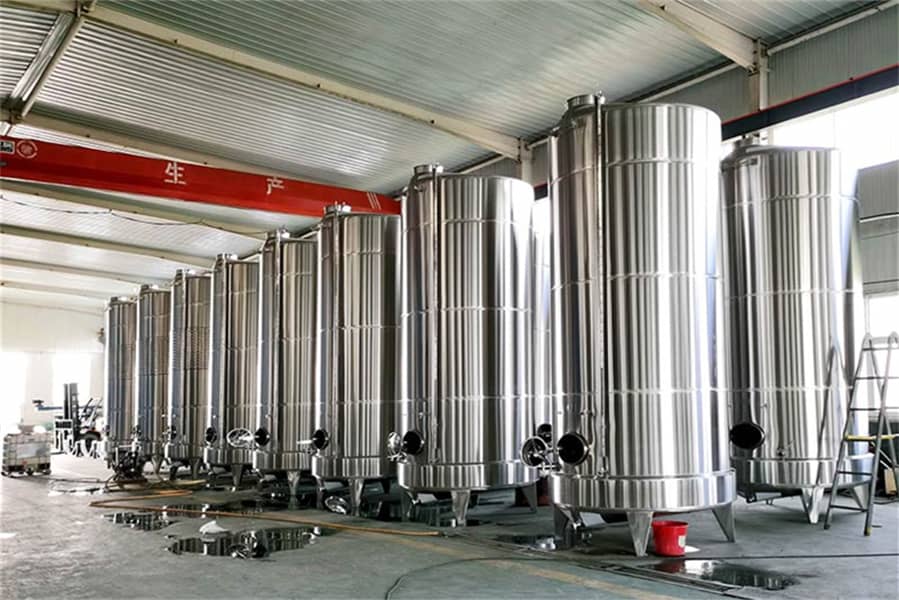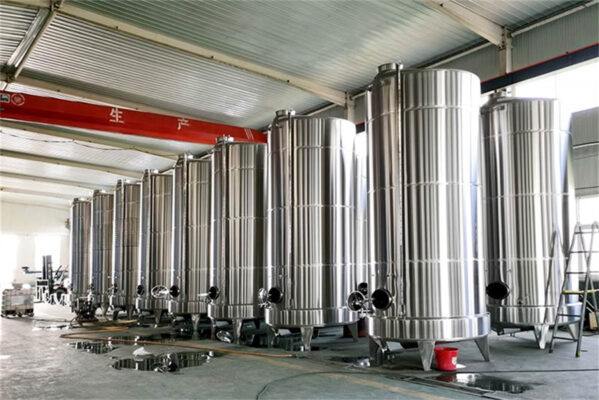Industriële brouwapparatuur verwijst naar de grootschalige systemen en machines die worden gebruikt om bier en andere gefermenteerde dranken in commerciële hoeveelheden te produceren. Met de stijgende populariteit van ambachtelijke bieren en microbrouwerijen is er een toenemende vraag naar geavanceerde brouwtechnologie om de efficiëntie, kwaliteit en output te verbeteren. Deze gids biedt bierproducenten alles wat ze moeten weten over het kiezen en bedienen van brouwhardware op industriële schaal.
Overzicht van industriële brouwsystemen
Industriële brouwapparatuur is verkrijgbaar in verschillende configuraties, van geïntegreerde tot modulaire ontwerpen, gericht op brouwerijen met verschillende productie-eisen. Belangrijke componenten zijn onder meer de brouwerij om zetmeel om te zetten in alcohol, fermentatie- en rijpingsvaten, filtratiesystemen, verpakkingslijnen, reinigingsopstellingen, enz. Moderne industriële brouwerijen maken gebruik van automatisering in productieprocessen voor nauwkeurige controle.
Bij het selecteren van apparatuur zijn de belangrijkste factoren waarmee u rekening moet houden:
Tabel 1: Belangrijkste overwegingen bij de selectie van industriële brouwerijapparatuur
| Parameters | Details |
|---|---|
| Productievolume | Batchgrootte, jaarlijkse productiecapaciteit |
| Productvariëteit | Aantal en stijlen geproduceerde bieren |
| Fysieke afmetingen | Vloeroppervlak en locatiebeperkingen |
| Budget | Apparatuurkosten en extra investeringen |
| Procesaanpassing | Flexibiliteit voor ambachtelijke stijlen en experimenten |
| Kwaliteitscontrole | Bewakingssystemen en automatiseringsmogelijkheden |
| Duurzaamheid | Water-, energieverbruik; schonere productie |
| Vaardigheidsniveau van het personeel | Vereisten voor bediening en onderhoud van apparatuur |
Industriële brouwapparatuur Gids
Industriële brouwopstellingen omvatten complexe, onderling verbonden systemen die verschillende functies in de bierproductieworkflow verzorgen.
Tabel 2: Belangrijkste soorten industriële brouwapparatuur
| Uitrustingscategorie | Sleutelfuncties en machines |
|---|---|
| Frezen | Hamer- en walsmolens om mout te vermalen |
| Mash-conversie | Pureerfilters, filterkuipen, pureerketels om suikers te extraheren |
| Wort koken | Koperen ketels voor het koken van wort en hoptoevoegingen |
| Whirlpool | Schepen die middelpuntvliedende kracht gebruiken om trub te scheiden |
| Koeling | Platenwarmtewisselaars, wortkoelers |
| Gisting | Open, gesloten tanks, conische vergisters met temperatuurregeling |
| Rijping | Gistscheiding, klaring, verouderingstanks |
| Koolzuur | Brite-tanks, carbonatatiestenen |
| Filtratie | Platenfilters, centrifuges, scheiders |
| Verpakking | Inblikkende lijnen, flessenvullers, vaten |
| CIP-systemen | Clean-in-place stations, schoonmaakchemicaliën |
| Automatisering | PLC's, HMI's, sensoren voor gegevensverzameling en -besturing |
Moderne commerciële brouwerijen maken gebruik van modulaire ontwerpen waarmee apparatuur kan worden aangepast aan specifieke behoeften op het gebied van batchvolumes, aantal geproduceerde merken, vereiste verpakkingsformaten, enz.
Capaciteiten, afmetingen, lay-outs
De productiecapaciteit, het vloeroppervlak, het locatieplan en de indeling zijn cruciale aspecten die van invloed zijn op de selectie van apparatuur voor industriële brouwerijen.
Tabel 3: Apparatuurcapaciteiten en fysieke parameters
| Overwegingen | Details | Aanbevelingen |
|---|---|---|
| Jaarlijks volume | Afhankelijk van doeloutput | Selecteer de schaal van de apparatuur die is afgestemd op het capaciteitsplan |
| Partijgrootte | Gekoppeld aan vergistervolumes | Standaardiseer rond belangrijke merken |
| Vaartuignummers | Gebaseerd op geproduceerde variëteiten | Houd het minimaal, optimaliseer planningen |
| Hoogtebeperkingen | Vrije ruimte voor tanks, leidingen, platforms | Plan vroeg voor de omstandigheden ter plaatse |
| Vloeroppervlak | Voldoende toegang voor onderhoud | Minimaliseer de afstanden tussen modules |
| Servicetoegang | Nutsvoorzieningen, afvalverwijdering | Zorg voor voldoende afstanden |
| Indelingsflexibiliteit | Uitbreidingsmogelijkheden | modulaire ontwerpen ondersteunen toekomstige groei |
Een grondige planning van productievolumes, merkenportfolio, batchgroottes en beschikbaarheid van fysieke ruimte is van cruciaal belang voor het bepalen van de apparatuurgrootte en het ontwerp van de faciliteiten. Het uitbreidingspotentieel moet tijdens de initiële bouw worden beoordeeld. Een geoptimaliseerde lay-out gericht op workflow- en onderhoudsaspecten verlaagt de bedrijfskosten op de lange termijn.
Leveranciers en prijzen
Er is een breed scala aan leveranciers van brouwerijapparatuur voor bedrijven van elke omvang. Kopers moeten leveranciers beoordelen op basis van reputatie, aanpassingsmogelijkheden en budgetafstemming.
Tabel 4: Leveranciers van brouwerijapparatuur en indicatieve prijzen
| Leveranciersprofiel | Budgetschattingen |
|---|---|
| Mondiale conglomeraten | > $5 miljoen voor kant-en-klare megabrouwerijen |
| Grote roestvrijstalen engineering cos | $2-5 miljoen voor geïntegreerde industriële systemen |
| Middelgrote fabrikanten | $500k-2 miljoen voor modulaire brouwerijen |
| Fabrikanten op maat | <$500k voor nano- en micro-opstellingen |
De prijs is afhankelijk van factoren zoals:
- Productiecapaciteit
- Mate van procesautomatisering
- Invoerrechten en belastingen
- Aanvullende accessoires en diensten
Offerteaanvragen met duidelijk gespecificeerde vereisten zullen betere reacties van leveranciers opleveren. Locatiebezoeken aan bestaande installaties zijn de moeite waard.
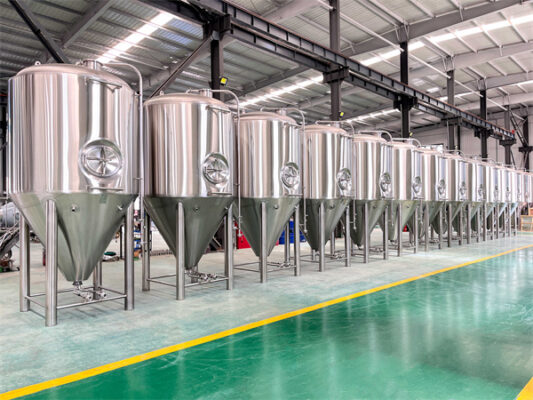
Installatie, bediening, onderhoud
Zorgvuldige installatie, bedieningsgemak, preventief onderhoud en snelle ondersteuning bij het oplossen van problemen zijn van cruciaal belang voor industriële brouwhardware.
Tabel 5: Uitvoering van installatie en doorlopend apparatuurbeheer
| Fase | Vereiste activiteiten |
|---|---|
| Installatie | Civiele, structurele, mechanische, elektrische werkzaamheden en leidingwerk;<br> Afhandeling van de levering van apparatuur; <br>Kalibratie, proefdraaien; |
| Operatie | SOP-documentatie;<br> Inspectieschema's; <br>Water, energie, verbruiksartikelen |
| Onderhoud | Preventieve onderhoudsschema's; <br>Toezicht op apparatuur; <br> Planning van de respons op storingen |
| Beheer | Training programmas; <br>Inventaris van reserveonderdelen; <br>Feedback van leveranciers |
Brouwers moeten de gereedheid van de constructie valideren voordat de apparatuur de locatie bereikt. De opleiding van het personeel voor standaardbedieningsprocedures en onderhoudstaken begint in de fase vóór de inbedrijfstelling. De energie-, water- en afvalwaterinfrastructuur moet gereed zijn voordat de productie wordt uitgerold.
Leveranciers van brouwerijapparatuur selecteren
Het kiezen van competente industriële brouwapparatuurpartners op basis van parameters zoals ervaring, schaal, maatwerkexpertise en ondersteuning na de installatie zorgt voor een soepele projectuitvoering.
Tabel 6: Evaluatiecriteria van leveranciers voor de aanschaf van brouwhardware
| Parameter | Beoordelingscriteria |
|---|---|
| Baanrecord | Jaren in zaken; Grootte klantenkring; Brouwerij portefeuille |
| Geschiktheid van het aanbod | Uitlijning van apparatuurcatalogi; Budget geschikt |
| Maatwerkvaardigheden | Ontwerpflexibiliteit; Integratiemogelijkheden |
| Orderverwerking | Betrouwbaarheid van de productie; Kwaliteitscontrole |
| Ontvankelijkheid | Doorlooptijden van offertes; Transparantie van informatie |
| After-sales service | Installatieondersteuning; Onderhoudscontracten |
| Referenties | Feedback van klanten; Brouwerijcontacten voor feedback |
Bijkomende overwegingen voor leveranciers zijn onder meer lokale aanwezigheid, reparatie-infrastructuur, trainingsdiensten, leveringszekerheid van reserveonderdelen en levering van upgrades. Bij de selectie is een locatiebezoek aan bestaande installaties aan te raden.
Voor-, nadelen en beperkingen
Voordelen van industriële brouwapparatuur
De passie voor een perfect gebrouwen bier mag dan klein beginnen, het opschalen van brouwactiviteiten vereist apparatuur die de ambitie kan evenaren. Hier komt industriële brouwapparatuur om de hoek kijken, die brouwerijen een wereld aan voordelen biedt die verder gaan dan alleen een groter volume. Van consistente kwaliteit tot operationele efficiëntie, laten we eens kijken naar de belangrijkste voordelen van deze apparatuur.
Kwaliteit verzekerd, consistentie gegarandeerd: Stel je voor dat je hetzelfde bier twee keer schenkt en het heel anders ervaart. Inconsistente kwaliteit kan de nekslag zijn voor de reputatie van elke brouwerij. Industriële apparatuur gaat dit tegen door precisie en automatisering te introduceren. Temperatuurcontrolesystemen handhaven optimale omstandigheden voor elke brouwfase, waardoor menselijke fouten tot een minimum worden beperkt en consistentie van batch tot batch wordt gegarandeerd. Geavanceerde filtratiesystemen zorgen voor nog meer helderheid en verwijderen ongewenste deeltjes, wat leidt tot een consistent glad en bevredigend eindproduct.
Efficiëntie viert hoogtij: Tijd is geld en industriële apparatuur begrijpt deze taal perfect. Door vervelende taken zoals wort overhevelen en schoonmaken te automatiseren, komt er waardevolle mankracht vrij zodat brouwers zich kunnen concentreren op hun creatieve bezigheden. Bovendien maken grotere vaten grotere batches mogelijk, waardoor de productieoutput wordt gemaximaliseerd zonder aan kwaliteit in te boeten. Dit vertaalt zich in een hogere winstgevendheid en de mogelijkheid om met gemak aan de groeiende vraag te voldoen.
Eenvoudige schaalbaarheid: Naarmate een brouwerij groeit, moet ook de apparatuur meegroeien. Industriële apparatuur is ontworpen met het oog op modulariteit, zodat brouwerijen naadloos nieuwe componenten kunnen toevoegen of bestaande componenten kunnen uitbreiden. Hierdoor zijn dure revisies van apparatuur overbodig en verloopt het schaalvergrotingsproces soepel. Of het nu gaat om het toevoegen van een nieuwe fermentor of het upgraden van filtratiesystemen, industriële apparatuur stelt brouwerijen in staat om zich aan te passen en te gedijen in een dynamische markt.
Veiligheid komt altijd op de eerste plaats: Werken met grote hoeveelheden hete vloeistoffen en systemen onder druk vereist een strikte focus op veiligheid. Industriële apparatuur bevat robuuste veiligheidsvoorzieningen zoals overdrukventielen en automatische afsluitmechanismen, waardoor het risico op ongelukken wordt geminimaliseerd en een veilige werkomgeving voor alle betrokkenen wordt gegarandeerd.
Gegevensgestuurde beslissingen: In de huidige datagestuurde wereld is informatie macht. Industriële apparatuur is vaak uitgerust met geavanceerde controlesystemen die temperaturen, drukken en andere belangrijke meetgegevens tijdens het brouwproces bijhouden. Dankzij deze schat aan gegevens kunnen brouwers waardevolle inzichten krijgen in hun activiteiten, verbeterpunten identificeren en hun recepten optimaliseren voor nog meer efficiëntie en kwaliteitscontrole.
Duurzaamheid in de kijker: Naarmate het milieubewustzijn groeit, richten brouwerijen zich steeds meer op het verkleinen van hun ecologische voetafdruk. Fabrikanten van industriële apparatuur reageren hierop met innovatieve oplossingen die energie-efficiënte functies bevatten en duurzame materialen gebruiken. Van warmteterugwinningssystemen tot waterbesparende reinigingsprotocollen, deze technologieën stellen brouwerijen in staat om hun passie op verantwoorde wijze te brouwen en hun impact op het milieu te minimaliseren.
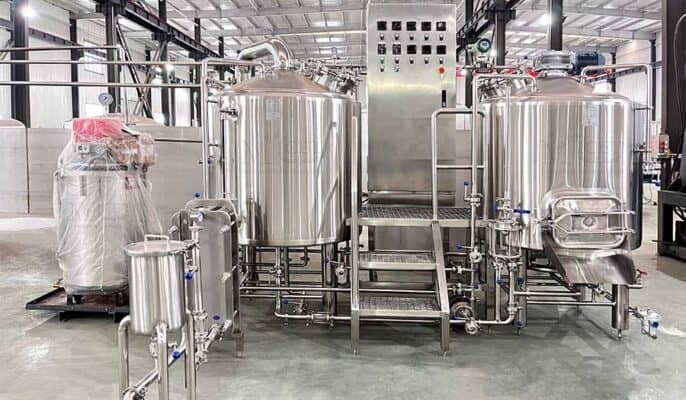
Nadelen van industriële brouwapparatuur
De aantrekkingskracht van industriële brouwapparatuur is onmiskenbaar. Ze beloven efficiëntie, precisie en de mogelijkheid om de productie naar nieuwe hoogten te schalen. Maar voor gepassioneerde brouwers is de weg geplaveid met roestvrijstalen kolossen niet altijd even gemakkelijk. Voordat je de sprong waagt, is het cruciaal om de mogelijke nadelen van deze krachtige machines te onderkennen.
De prijs van precisie: Hoewel consistentie een deugd is, kan overmatige controle de creativiteit verstikken. Industriële apparatuur, met zijn geautomatiseerde routines en gestandaardiseerde processen, kan weinig ruimte overlaten voor experimenten. De magische toets van een praktische brouwer, die de temperatuur op gevoel aanpast of ingrediënten toevoegt op basis van intuïtie, wordt minder relevant. Deze homogenisering kan leiden tot bieren die technisch perfect zijn, maar die de unieke ziel missen waar ambachtelijke brouwerijen bekend om staan.
Flexibiliteit verspeeld: Hoewel modulariteit groei mogelijk maakt, vertaalt het zich niet in onmiddellijke aanpassing. Een nieuwe tank toevoegen of een recept veranderen binnen een industriële opstelling kan een complex en tijdrovend proces zijn. Kleinere brouwsystemen bieden daarentegen de flexibiliteit om snel te sleutelen en aan te passen, waardoor gelukkige ongelukjes en spontane receptaanpassingen tot spannende nieuwe ontdekkingen kunnen leiden.
De hoge toegangskosten: De initiële investering in industriële apparatuur is aanzienlijk. Niet alleen de machines zelf zijn duur, maar ook de installatie en het onderhoud vereisen gespecialiseerde expertise en infrastructuur. Deze hoge instapdrempel kan ontmoedigend zijn voor kleine en aspirant-brouwerijen, waardoor de diversiteit aan stemmen en brouwstijlen op de markt mogelijk beperkt wordt.
Duurzaamheidsscepticisme: Hoewel er stappen worden gezet in de richting van milieuvriendelijke oplossingen, verbruikt industriële apparatuur inherent meer hulpbronnen dan kleinere installaties. Grootschalig brouwen verbruikt meestal meer water, energie en reinigingschemicaliën, waardoor de ecologische voetafdruk groter is. Voor brouwerijen die zich inzetten voor duurzame praktijken, vraagt deze afweging om een zorgvuldige afweging.
De menselijke aanraking vervaagt: Automatisering is een tweesnijdend zwaard. Hoewel het mankracht vrijmaakt voor andere taken, haalt het de brouwer ook weg van de directe interactie met de ingrediënten. Deze onthechting kan leiden tot een gebrek aan voeling met het brouwproces, wat de passie en de band die velen aantrekt tot het brouwen kan verminderen.
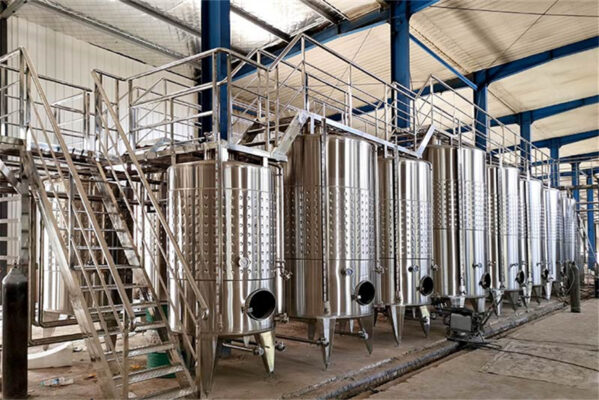
Beperkingen van industriële brouwapparatuur
Industriële brouwapparatuur, met zijn imposante tanks en glanzend chroom, belichaamt de kracht van precisie en schaal. Maar achter deze façade van efficiëntie schuilt een wereld van beperkingen. Net zoals torenhoge bergen adembenemende vergezichten bieden maar spontane exploratie beperken, leggen deze kolossen van het brouwen grenzen op aan de creatieve geest en vragen ze om een dieper begrip van hun beperkingen.
Grootte is belangrijk, maar niet altijd ten goede: Hoewel grote batches de winstgevendheid stimuleren, kunnen ze ook creatieve handboeien worden. Experimenteren, het levensbloed van ambachtelijk brouwen, gedijt bij kleinschalige proeven, waardoor brouwers recepten kunnen verfijnen en de subtiele nuances van smaken kunnen ontdekken. Grootschalig brouwen vereist daarentegen een onwrikbare toewijding aan een recept, waardoor er minder ruimte is voor spontane aanpassingen en toevallige ontdekkingen.
Flexibiliteit raakt op de achtergrond: In tegenstelling tot een beeldhouwer met een klomp klei, volgen brouwers met industriële apparatuur een vooraf bepaald pad. Recepten aanpassen of op het laatste moment ingrediënten veranderen wordt een logistieke dans, waarbij temperatuurprofielen en reinigingsschema's moeten worden aangepast. Deze starheid kan de wendbaarheid verstikken die nodig is om vluchtige kansen te grijpen en in te spelen op dynamische markttrends.
De persoonlijke benadering gaat verloren: Als je op het platform van een industriële brouwerij stapt, kun je een symfonie van geautomatiseerde pompen en kleppen tegenkomen, maar de menselijke inbreng verdwijnt naar de achtergrond. De intieme band met het brouwproces, de intuïtieve aanpassingen op basis van geur en textuur, worden grotendeels vervangen door datagestuurde beslissingen en voorgeprogrammeerde cycli. Deze ontkoppeling kan de ziel van het bier aantasten en mogelijk het unieke karakter en de diepgang die ambachtelijk brouwen definiëren opofferen.
Standaardisatie kweekt gelijkenis: Van de glanzende tanks tot de geautomatiseerde processen, industriële apparatuur staat voor uniformiteit. Hoewel deze consistentie voorspelbare resultaten verzekert, kan het ook leiden tot homogenisering. De geproduceerde bieren zijn weliswaar vlekkeloos uitgevoerd, maar missen misschien de kenmerkende persoonlijkheid en regionale flair die liefhebbers van ambachtelijk bier zo enthousiast maken.
Kostbaar onderhoud, ecologische voetafdruk: Aan de initiële investering in industriële apparatuur hangt een stevig prijskaartje, maar de kosten reiken veel verder. Het onderhoud van deze complexe systemen vereist deskundige technici en gespecialiseerde reinigingsprotocollen. Bovendien leidt alleen al de schaalgrootte tot een hoger water- en energieverbruik, waardoor de ecologische voetafdruk groter is dan bij kleinere installaties.
De beperkingen van industriële brouwapparatuur zijn niet bedoeld om te ontmoedigen, maar eerder om te informeren. Het erkennen van deze beperkingen stelt brouwers in staat om weloverwogen beslissingen te nemen, de sterke punten van deze systemen te benutten en tegelijkertijd creatieve oplossingen te zoeken en alternatieve benaderingen te omarmen. Uiteindelijk ligt de weg naar uitmuntendheid in het brouwen niet in het blindelings overnemen van hulpmiddelen, maar in het begrijpen van hun beperkingen en ze te gebruiken om het vakmanschap van de brouwer te versterken in plaats van te beperken. Alleen dan kunnen de industriële reuzen in harmonie dansen met de creatieve menselijke geest en bieren produceren die zowel precisie als ziel uitstralen.
Tabel 7: Vergelijking van de belangrijkste voordelen versus beperkingen
| Parameters | Voordelen en voordelen | Nadelen en uitdagingen |
|---|---|---|
| Volumes | Hoge output; Schaalvoordelen | Coördinatiecomplexiteit; Inventaris |
| Automatisering | Precisie; Herhaalbaarheid; Gegevensinzichten | Inflexibele processen; Kosten van apparatuur |
| Rassen | Mogelijkheid om diverse merken te produceren | Extra tanks; Omschakelingen |
| Kwaliteit | Geavanceerde procescontrole; Conditiestabiliteit | Strenge CIP-behoeften |
| Voetafdruk | Compact in vergelijking met capaciteit | Behoeften voor site-ontwikkeling |
| Ops-vaardigheden | Gespecialiseerde technische teams | Trainingsoverhead |
Hoewel moderne industriële apparatuur voor het maken van bier enorme productiviteits- en efficiëntiewinsten oplevert, moeten brouwers de voordelen afwegen tegen de aanzienlijke kapitaal- en bedrijfskosten die daarmee gepaard gaan.
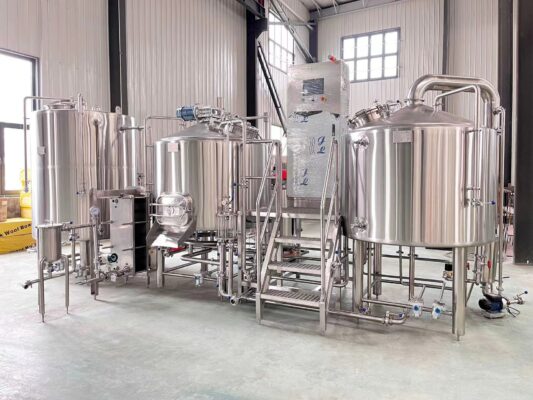
FAQ
Wat zijn de typische kosten voor het opzetten van industriële brouwerijapparatuur?
- De kosten variëren aanzienlijk, afhankelijk van de productievolumes en de mate van automatisering – van ongeveer $500.000 voor een basisbrouwerij van 10.000 hl tot meer dan $5 miljoen voor een ultramoderne faciliteit van 500.000 hl.
Wat zijn de vloeroppervlakvereisten voor een industriële brouwerij?
- Houd als richtlijn ongeveer 1,5 tot 2 vierkante meter ruimte aan. per jaarlijks vat bier dat alleen voor de brouwerij wordt geproduceerd. Er is meer ruimte nodig voor fermentatie, rijping en opslag.
Wat zijn de meest voorkomende merken van apparatuur voor het maken van bier?
- Toonaangevende OEM's van wereldwijde apparatuur zijn onder meer Alfa Laval, GEA Group, Krones, Paul Mueller en Praj. Veel op maat gemaakte roestvrijstalen fabrikanten richten zich ook op industriële brouwerijen.
Welke productievolumes definiëren een micro- versus macro-industriële brouwerij?
- Microbrouwerijen produceren minder dan 15.000 vaten per jaar. Grote macrobrouwerijen produceren jaarlijks meer dan 6 miljoen vaten.
Hoeveel tijd kost een industriële brouwerijinstallatie?
- De tijdlijnen bestrijken 6-12 maanden, afhankelijk van de schaal, en omvatten de voorbereiding van de locatie, leveringsschema's en installatie van apparatuur, proefdraaien, proefbrouwen en commerciële lancering.
Meer weten over brouwapparatuur




